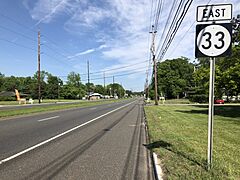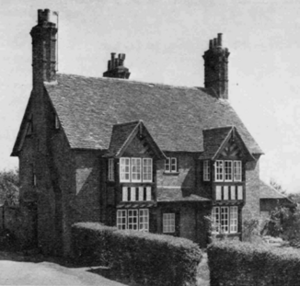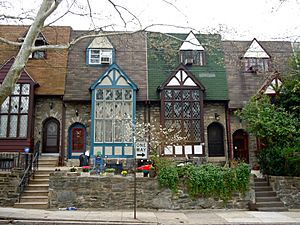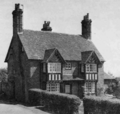Suburb facts for kids
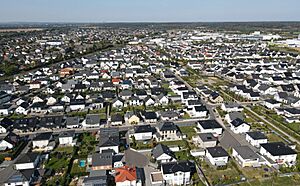
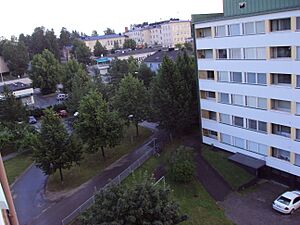
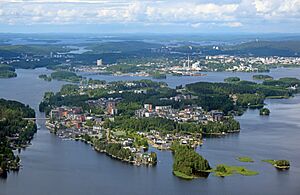

A suburb is a living area that is mostly homes. It is usually found near a large city. People often travel from suburbs to the city for work or other activities.
Suburbs can be their own towns with their own rules. This is common in the United States. But in places like the United Kingdom, suburbs are often part of the main city. In many English-speaking countries, suburbs are different from the busy city center. However, in Australia and South Africa, the word "suburb" can just mean any part of a city, like a "neighborhood" in the U.S.
Sometimes, suburbs in the United States have more people and higher incomes than the older parts of the city nearby. This happened partly because of historical changes where many people moved out of cities.
In some countries, like India, China, and Canada, new suburbs are often added to nearby cities as the cities grow. In other places, like France and parts of the United States, many suburbs stay as separate towns. Areas even further out than suburbs are called "exurbs." Exurbs have fewer people than suburbs but more than rural areas. Suburbs and exurbs are often connected to the main city by jobs and people traveling to work.
Suburbs became common in the 1800s and 1900s. This happened because trains and roads made it easier to travel. Suburbs usually have fewer people living in each square mile than city centers. Most people living in suburbs travel to city centers for work. They often use cars or public transportation. But there are exceptions, like suburbs built for factories or special planned communities. Suburbs tend to grow easily around cities that have a lot of flat land nearby.
Contents
What Does "Suburb" Mean?
The word "suburb" comes from an old French word, subburbe. This word came from the Latin word suburbium. Sub means "under" or "below," and urbs means "city." So, it literally means "under the city" or "near the city." The first time the word was used in English was around the year 1350.
Suburbs Around the World
The meaning of "suburb" can change depending on where you are.
Australia, New Zealand, and South Africa
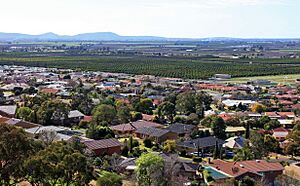
In Australia, New Zealand, and South Africa, suburbs are official parts of a city. They are used for mailing addresses. People use terms like "inner suburb" and "outer suburb." Inner suburbs are closer to the city center and often have more apartments. Outer suburbs are further out and have more single-family homes.
North America
In the United States and Canada, a suburb can be a living area outside a city. It can also be a separate town or area near a city. Most Americans think they live in a suburb. But the U.S. government does not have an official definition for what a suburb is.
United Kingdom and Ireland
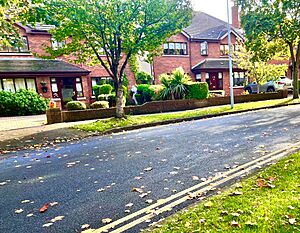
In the United Kingdom and Ireland, a suburb is simply a living area outside the city center. It does not matter if it is part of the city's official boundary or not. Many suburbs in big cities like London used to be separate towns. They were later absorbed as the city grew. Examples include Ealing and Bromley in London, and Swords in Dublin.
How Suburbs Grew Over Time
The story of suburbs is part of city history. It looks at how suburbs started, how they grew, and what kind of places they became. Many people used to think that early suburbs were only for middle-class white families. But this is not always true. Some suburbs were built for working-class families or minority groups who wanted to own their own homes. However, some suburbs in the U.S. did have rules that kept certain people out.
Early Suburbs
The first suburbs appeared when cities first started to grow. Large cities often had smaller villages around them. The Roman statesman Cicero used the word suburbani to describe the large homes built by rich Romans outside the city.
In ancient China, the capital city Luoyang had many people living in small towns just outside its walls. These were like suburbs. As cities in Europe grew, people from the countryside moved in. Sometimes, nearby villages became part of the expanding city. The areas on the edge of the city were often where the poorest people lived.
Modern Suburbs Begin
In the late 1700s, many poor people moved to industrial cities in England. At the same time, some rich middle-class people started buying homes outside London. This trend grew in the 1800s, especially in fast-growing cities like London and Birmingham. The first suburban areas appeared around city centers. People wanted to escape the crowded and unhealthy conditions of industrial towns.
At first, suburbs grew along train lines. People could take the train to work in the city. In Australia, suburbs with larger plots of land became popular in the 1850s. This was part of the "Australian Dream."
Later, public transportation like underground railways, trams, and buses made it possible for more people to live outside the city. They could still travel to the city for work.
By the mid-1800s, London was the largest city in the world. It was becoming very crowded. The opening of the Metropolitan Railway in the 1860s helped suburbs grow. This train line connected the city's financial center to new suburban areas. The railway company even bought land and built homes to sell, creating places like Wembley Park. They called these areas "Metro-land" to encourage people to move there. They promised a modern home in beautiful countryside with fast train service to central London.
Suburban Growth in England (1918-1939)
After World War I, the government wanted to build more homes. They passed a law in 1919 that allowed for large new housing areas in the suburbs. This was the start of government-owned housing in England. The law also set rules for how new suburban homes should be built. It said how many homes could be in an area and how many rooms each house should have.
The "semi-detached" house (two homes sharing a wall) became very popular during this time. Middle-class families liked them more than smaller "terraced" houses (rows of homes sharing walls). Many of these new homes had designs influenced by the Art Deco style.
In just ten years, suburbs grew a lot. For example, Harrow Weald grew from 1,500 people to over 10,000. By the 1930s, over 4 million new suburban houses were built. England became the most suburbanized country in the world.
North American Suburbs
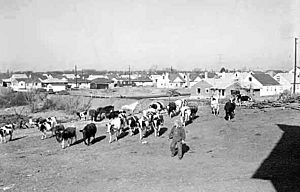

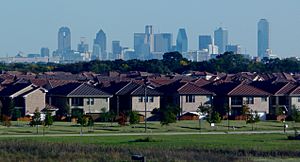
Boston and New York City were among the first places to have major suburbs. Streetcar lines in Boston and train lines in New York made it possible for people to travel to work every day. Wealthy families built homes in villages like Scarsdale and Rye in Westchester, New York.
After World War II
The number of people living in North American suburbs grew very quickly after World War II. Soldiers returning from the war wanted to settle down. Places like Levittown became famous for building many homes quickly.
As suburbs grew, more shopping centers were built. These malls offered many stores and services in one place. This made shopping easier for people in the suburbs. The growth of highways also helped. The Highway Act of 1956 provided money to build many new roads. These roads made it easy to drive to shopping centers. These centers became places for shopping, fun, and meeting friends. By 1960, there were over 2,000 shopping centers.
Housing Boom
During the Great Depression and World War II, not many new homes were built. Many families lived in crowded apartments. But after the war, people had saved money. They wanted to buy homes, cars, and appliances. This led to a huge housing boom. From 1946 to 1955, about 1.45 million new homes were built each year.
The G.I. Bill helped veterans get low-cost loans to buy homes. In 1947 alone, 540,000 veterans bought houses. Builders kept prices low by using standard sizes for things like kitchen cabinets. Developers bought empty land outside cities. They built many similar homes, streets, and utilities. Local officials worked to build schools. Levittown, New York, was a famous example. A new house there cost $1,000 down and $70 a month. It had three bedrooms, a fireplace, and a nice yard.
At the same time, many African Americans moved north and west for better jobs and education. Their arrival in cities led to some social changes. Many white families moved to the suburbs. This was called "white flight." Government housing policies also played a role. They sometimes made it harder for African Americans to get mortgages in certain areas. This led to more separation between different groups of people.
After the war, loans from the Federal Housing Administration (FHA) helped suburbs grow. In older cities, suburbs first grew along train or trolley lines. These lines took workers to jobs in the city centers. This is why suburbs were sometimes called "bedroom communities." People slept in the suburbs but worked in the city.
The U.S. economy grew, and people had more money to spend. This also helped suburbs grow. Suburban homes created new needs, like lawnmowers and cars. Shopping malls were built near suburbs to meet these needs.
Zoning laws also helped shape suburbs. These laws set aside large areas just for homes. Suburban homes are usually built on bigger pieces of land than city homes. For example, a suburban lot might be much wider than a city lot. Factories and businesses were put in different areas.
Many companies also started moving their offices to the outer parts of cities. This made some older suburbs grow even more. It also led to new, less crowded suburbs further from city centers. Some people tried to combine the best parts of city and country life in "garden cities."
By 1950, more people in the U.S. lived in suburbs than anywhere else. The growth of tall buildings in city centers also meant more businesses moved downtown. This pushed more people to live outside the city center.
Suburbs Today

Suburbs in the United States often have single-family homes. They are known for:
- Fewer people per square mile than city centers.
- Homes on small plots of land, often very similar to each other.
- Zoning laws that separate homes from businesses. This means you often need a car to get to stores.
- A higher percentage of white residents, though this is changing. More people from minority groups are moving to suburbs.
- Neighborhoods built by one company. These areas can be very similar in terms of home values and the types of families living there.
- Shopping malls and strip malls with large parking lots, instead of traditional downtown shopping areas.
- Roads designed in a special way, with streets that end in circles (culs-de-sac) leading to larger roads. This is different from the grid pattern in many city centers.
- More one-story buildings for offices.
- Compared to rural areas, suburbs have more people, better roads, more chain stores, and less farmland.
By 2010, more people from minority groups moved to suburbs. They gained better education and looked for better living conditions. At the same time, some white Americans moved back to city centers. Many city downtowns are growing again, with new apartments and more cultural activities. Better public transportation and being close to work have attracted young people to city centers. The number of Hispanic and Asian people in the suburbs is also growing.
Traffic and Travel
Suburbs often have longer travel times to work than older city neighborhoods. This is because:
- People almost always need a car. Bus and train systems are often not as good as in cities.
- Travel distances are longer.
- The way roads are designed can make traffic worse. Neighborhoods often depend on one or two main roads. All cars are forced onto these roads, which can make them very busy. If there is a crash or road work, the whole system can get stuck. Older city grids offer more choices for routes.
Suburban areas can also be difficult for people who walk or bike. Direct paths are often not available. This encourages people to use cars even for short distances. Some newer suburban designs try to fix this by adding bike paths and walking trails. These paths connect different parts of the suburb, allowing people to travel more directly without a car.
Cities sometimes try to tax people who work downtown but live in the suburbs. This is called a commuter tax. Cities do this to get more money as their own tax bases shrink. This money can help pay for roads and other city services that commuters use.
Today, many companies are also moving their offices to suburbs. This is because land and property costs are often lower there.
Images for kids
See also
 In Spanish: Suburbio para niños
In Spanish: Suburbio para niños



